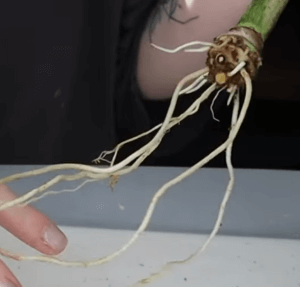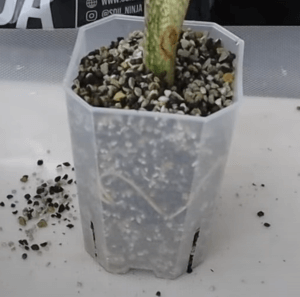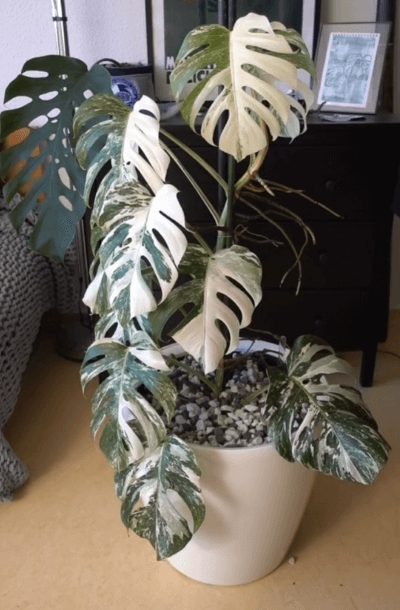Have you ever wondered if there’s a simpler, more effective way to nurture your beloved houseplants?

Enter the world of semi-hydroponics – a method that’s revolutionizing indoor gardening.
In this beginner-friendly guide, we’ll explore the transition of houseplants from traditional soil to Lechuza Pon, a premium semi-hydroponic medium.
Whether you’re a green thumb or just starting, you’ll find that moving to semi-hydroponics can bring a refreshing change to your plant care routine.
Summary
Transitioning Houseplants to Semi-Hydroponics with Lechuza Pon
- Selecting the Right Plants:
- Ideal for hardy varieties like philodendrons, pothos, alocasia, and orchids.
- Not suitable for dry condition-loving plants like cacti or succulents.
- Preparation and Tools:
- Sterilized scissors, container for soaking roots, semi-hydroponic pot, Lechuza Pon.
- Hydrate Lechuza Pon before use and choose a well-draining pot.
- Transitioning Process:
- Remove plant from soil, clean roots, and trim if necessary.
- Risen Pon to remove the dust.
- Plant in Lechuza Pon, ensuring even coverage around roots.
- Initial watering to settle the medium.
- In the first two weeks, treat Pon as a regular medium. Water it once every few days when the soil is dry.
- Aftercare and Maintenance:
- Monitor moisture, adjust watering schedule.
- Initially, no additional fertilization needed; after a few months, use diluted liquid fertilizer.
- Observe plant health, troubleshoot common issues.
- Semi-hydroponics with Lechuza Pon simplifies plant care, enhances plant health, and is suitable for a variety of houseplants. Patience is essential for the adjustment period.
Semi-Hydroponics and Lechuza Pon
What is Semi-Hydroponics?
Semi-hydroponics is an innovative way of growing plants without soil. It involves using an inert, porous medium to support the plant’s root system, allowing better air flow and more efficient water delivery.
This method reduces common problems like overwatering and underfeeding, making plant care more forgiving and enjoyable.
The Benefits of Semi-Hydroponics for Houseplants
- Consistent Moisture Delivery: Roots receive a balanced amount of water, reducing the risk of root rot.
- Enhanced Oxygen Access: The medium’s porosity ensures ample oxygen, promoting healthier root systems.
- Simplified Maintenance: Semi-hydroponics streamlines watering and feeding, making plant care less time-consuming.
Read more: What is semi-hydroponics?

Lechuza Pon: The Ideal Semi-Hydroponic Medium
Lechuza Pon is a thoughtfully engineered blend, distinct in its composition, designed specifically for semi-hydroponic gardening. Its primary components include:
- Zeolite: This natural mineral is known for its ability to regulate moisture. It helps in retaining water and then gradually releases it, providing consistent hydration to the roots.
- Pumice: The inclusion of pumice in Lechuza Pon aids in aeration. This volcanic rock keeps the medium light and airy, allowing roots to breathe and grow more vigorously.
- Lava Rocks: These offer excellent drainage, preventing water from pooling around the roots. Their porous nature supports a stable supply of air and water to the plant.
- Fertilizer: Lechuza Pon also comes pre-enriched with a slow-release fertilizer that provides plants with essential nutrients for up to six months, reducing the need for frequent fertilization.
Why Choose Lechuza Pon?
- Balanced Water and Nutrient Delivery: Its unique composition ensures that your plants receive the right amount of water and nutrients, avoiding common issues like over or under-watering.
- pH Neutral and Low Salt Content: Lechuza Pon is pH neutral, making it suitable for a wide range of houseplants. Its low salt content also means it’s safe for sensitive plant species.
- Long-lasting and Reusable: Unlike traditional soil that breaks down over time, Lechuza Pon maintains its structure, offering a sustainable and long-term growing medium. It can be rinsed and reused, making it an environmentally friendly option.
Lechuza Pon’s unique blend of ingredients provides an optimal environment for houseplants, promoting healthy growth and reducing maintenance hassles. Whether you’re a seasoned gardener or new to plant care, Lechuza Pon offers an innovative solution to elevate your indoor gardening experience.
Read more: What is Pon?
Preparing for the Transition
Selecting the Right Plants
Not all houseplants are immediately suitable for a semi-hydroponic setup. Start with hardy varieties that adapt well to changes, such as philodendrons, pothos, alocasia, or orchids.
Avoid plants that prefer dry conditions, like cacti or succulents, as they might struggle with the consistent moisture in Lechuza Pon.
What you need
Prepare yourself with the right tools for a smooth transition:
- Sterilized scissors or pruning shears for root trimming.
- A container for soaking and rinsing roots.
- Lechuza Pon and an appropriate semi-hydroponic pot.
- A pair of gloves to protect your hands (Optional)
Preparing Lechuza Pon
Before using Lechuza Pon, it’s important to hydrate it properly. Soak it in water for about 10-15 minutes, allowing the medium to absorb moisture.
Drain any excess water before using it to ensure it’s not overly saturated.
Getting the Pot Ready for Pon Medium
Choosing the Right Pot
Select a pot with sufficient drainage to prevent waterlogging. Semi-hydroponic pots often come with a water reservoir, allowing for a self-watering system that is ideal for Lechuza Pon.
Ensure the pot size is appropriate for your plant, providing enough room for root growth.
Do note that Alocasia prefers a bit smaller pot compared to the other houseplants.
Setting Up the Pot
Start by placing a layer of Lechuza Pon at the bottom of the pot. This initial layer serves as a foundation, ensuring proper drainage and aeration. If your pot has a water reservoir, make sure the Lechuza Pon reaches into it slightly. This allows the roots to access water as needed, promoting healthy growth.
Transferring Plants from Soil to Lechuza Pon
Step 1: Removing the Plant from Soil
- Gently Remove the Plant: Carefully take your plant out of its current pot. Tap the pot’s sides and bottom to loosen the soil and roots.
- Shake Off Excess Soil: Hold the plant at its base and gently shake it to remove loose soil from the roots. Be gentle to avoid damaging the root system.

Step 2: Cleaning the Roots
- Rinse Thoroughly: Place the plant’s roots under lukewarm, running water. Gently rinse away the remaining soil. For delicate roots, you can soak them in water to help loosen the soil.
- Trim Damaged Roots: Using sterilized scissors or pruning shears, carefully trim away any dead, damaged, or excessively long roots. Healthy roots are typically firm and light in color.
Step 3: Planting in Lechuza Pon

- Risen Pon thoughtfully before using it. There should be a lot of dust in Pon.
- Positioning the Plant: Place your plant in the center of the pot. Gently spread out the roots over the layer of Lechuza Pon.
- Adding Lechuza Pon: Carefully add more Lechuza Pon around the roots, ensuring they are evenly covered. The medium should support the plant firmly but not be packed too tightly.
- Initial Watering: Once planted, water your plant thoroughly. This helps settle the Lechuza Pon around the roots and initiates the capillary action necessary for the self-watering system.
Tip: In the first two weeks, treat Pon as a regular medium. This means you just need to water it once every few days when the soil is dry (check the Zeolite color).
Pon Aftercare and Maintenance
Watering Schedule
- Check Moisture Level: Initially, monitor the moisture level in the pot regularly. Lechuza Pon should remain slightly moist but not waterlogged. In short, you can just keep the water 1-2cm under the roots in the first weeks.
- Adjust Watering Frequency: Over time, you’ll notice a pattern in how your plant consumes water. Adjust your watering schedule accordingly. Generally, plants in Lechuza Pon require less frequent watering than those in the soil initially.
Nutrient Management
- Initial Fertilization: Since Lechuza Pon contains a slow-release fertilizer, additional feeding isn’t needed for the first few months.
- Ongoing Nutrition: After the initial period, use a liquid fertilizer at half the recommended strength every other watering to maintain nutrient levels.
Read more: Nutrient and Fertilizer for Semi-hydroponics
Monitoring Plant Health
- Watch for Signs of Stress: After transitioning, plants might show signs of stress like drooping or yellowing leaves. This is often temporary as they adapt to the new medium.
- Troubleshooting Common Issues: If problems persist, assess the root health, moisture level, and nutrient supply. Adjust your care routine based on your observations.
Conclusion
Transitioning to semi-hydroponics with Lechuza Pon is a journey worth embarking on. It not only simplifies plant care but also opens up new possibilities for healthier, more vibrant houseplants.
Remember, patience is key. Give your plants time to adjust, and soon enough, you’ll see the fruits of your labor – lush, thriving greenery that brings life to your space.



